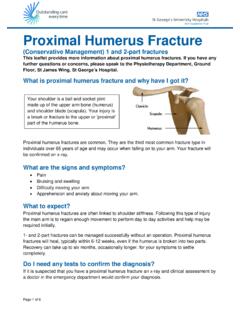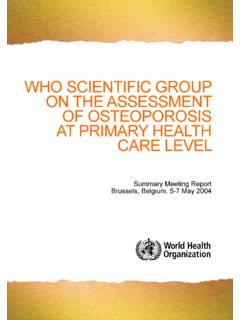Transcription of National Health Statistics Reports - Centers for Disease ...
1 National Health Statistics Reports Number 103 March 28, 2017 FRAX-based Estimates of 10-year Probability of Hip and Major Osteoporotic fracture Among Adults Aged 40 and Over: United States, 2013 and 2014 by Anne C. Looker, , and Neda Sarafrazi Isfahani, , National Center for Health Statistics ; and Bo Fan, , and John A. Shepherd, , University of California, San Francisco Abstract Background The FRAX algorithm estimates the 10-year probability of hip and major osteoporotic (clinical spine, forearm, hip, or humerus) fracture for adults aged 40 and over. An expert panel developed criteria to define elevated FRAX probabilities for adults aged 50 and over. This report uses FRAX estimates from the National Health and Nutrition Examination Survey 2013 2014 to describe the hip and major osteoporotic fracture probability distribution (for adults aged 40 and over) and prevalence of elevated probabilities (for adults aged 50 and over) in the United States.
2 Methods FRAX version was used to calculate fracture probability from risk factors that were measured ( , femur neck bone mineral density, height, and weight) or self-reported ( , fracture history, glucocorticoid use, rheumatoid arthritis, smoking, and alcohol intake). Among adults aged 50 and over, elevated probabilities were defined as 3% or greater for hip fracture and 20% or greater for major osteoporotic fracture . Results Mean skew-adjusted fracture probabilities were for hip fracture and for major osteoporotic fracture among adults aged 40 and over, and and , respectively, among adults aged 50 and over. The percentages of adults aged 50 and over with an elevated hip or major osteoporotic fracture probability were 19% and 8%, respectively. fracture probabilities varied significantly by age (older groups had higher probabilities than younger groups), sex (women had higher probabilities than men), and race and Hispanic origin (non-Hispanic white persons had higher probabilities than all other race and Hispanic groups) (p < ).
3 An estimated 95% 97% of adults aged 50 and over with an elevated probability of either fracture type had femoral neck osteoporosis or low bone mass. Conclusions Mean hip and major osteoporotic fracture probabilities were and , respectively, for adults aged 40 and over. Among adults aged 50 and over, mean hip and major osteoporotic fracture probabilities were (19% with elevated values) and (8% with elevated values), respectively. Keywords: fracture risk prediction osteoporosis National Health and Nutrition Examination Survey (NHANES) Introduction Fractures due to osteoporosis are a serious concern in the United States due to their economic burden as well as their negative impact on Health and well-being (1,2). Osteoporosis is currently defined on the basis of bone mineral density (BMD) (3) because BMD is a strong predictor of future fracture . However, many fractures occur in persons with BMD values that fall above the osteoporosis threshold (2).
4 Thus, measuring BMD only partially identifies the population segment who are at risk of fracture . To address this discrepancy, researchers at the World Health Organization (WHO) Collaborating Centre at Sheffield, United Kingdom, in the early 2000s developed a more global evaluation of fracture risk than that based on BMD alone (4). As part of the effort, a number of clinical risk factors that predict fracture independently of BMD ( , lifestyle and Health history risk factors easily assessed in primary care settings) were identified and validated using data from a large number of international, prospective population- based cohorts (4). An algorithm, called FRAX, was then developed to integrate these risk factors with mortality data to estimate the 10-year absolute probability DEPARTMENT OF Health AND HUMAN SERVICES Centers for Disease Control and Prevention National Center for Health Statistics Page 2 National Health Statistics Reports Number 103 March 28, 2017 of hip and major osteoporotic (clinical spine, forearm, hip, or humerus) fracture among adults aged 40 and over (4).
5 Risk factors used in the algorithm include age, sex, femur neck BMD, body mass index (BMI), prior fragility fracture , parental history of hip fracture , glucocorticoid use, rheumatoid arthritis, current smoking, excess alcohol consumption, and secondary osteoporosis. Separate FRAX algorithms have been developed for different countries using country- specific fracture and mortality data (4). The Food and Drug Administration has approved incorporating the FRAX algorithm into dual energy X-ray absorptiometry (DXA) systems so that FRAX estimates can be provided in addition to BMD results when DXA scans are performed (5 7). FRAX-based 10-year fracture probability estimates are currently used in many National and international osteoporosis guidelines (5,8), including several guidelines used in the United States (9 12). One of these guidelines, developed by the National Osteoporosis Foundation on the basis of a cost-effective analysis, includes criteria to define elevated fracture probabilities applicable to adults aged 50 and over (9).
6 Although FRAX-based estimates of 10-year fracture probabilities, or FRAX scores, are widely used in the United States, the distribution of these fracture probability scores among the adult population has not been previously described. This report provides detailed information about the FRAX score distribution for adults aged 40 and over using data from the National Health and Nutrition Examination Survey (NHANES) conducted in 2013 and 2014. Information on the prevalence of the risk factors used in the FRAX algorithm among adults aged 40 and over, and the prevalence of elevated FRAX scores among adults aged 50 and over, are also provided. Methods Data source The present study used data collected in NHANES 2013 2014, which was conducted by the National Center for Health Statistics (NCHS) to assess the Health and nutritional status of a representative sample of the noninstitutionalized, civilian population.
7 A complex, multistage probability sample design was used to select the sample (13,14). NHANES collects data via household interviews and direct standardized physical examinations conducted in specially equipped mobile examination Centers (14). All procedures in NHANES 2013 2014 were approved by the NCHS Research Ethics Review Board, and written informed consent was obtained from all participants. The unweighted examination response rate for adults aged 40 and over, the age range for which 10-year fracture probability scores were calculated, was 61% for NHANES 2013 2014. The analytic sample was derived from the 3,708 adults aged 40 and over participating in NHANES 2013 2014 who received physical examinations. Of these, 581 ( ) were excluded because they lacked valid femur neck BMD, height, or weight data. The final main analytic sample consisted of 3,127 respondents. Measures BMD Proximal femur scans were obtained via DXA using Hologic Discovery A densitometers (Hologic Inc.)
8 , Marlborough, Mass.) in NHANES 2013 2014. The femur scans were analyzed with Apex software. Details of the DXA examination protocol have been published elsewhere (15). Rigorous quality control (QC) programs were used to monitor DXA scanners. All QC and respondent scans were analyzed and reviewed by an expert at a central site (Department of Radiology at University of California, San Francisco [UCSF]) using standard radiologic techniques and study-specific protocols developed for NHANES (15). Femur neck BMD of adults aged 50 and over was categorized as normal, low bone mass, or osteoporosis using criteria recommended by WHO (16). T scores were calculated as: BMDrespondent mean BMDreference group Standard deviationreference group Normal was defined as a T score greater than ; low bone mass as a T score between and ; and osteoporosis as a T score of or less. Based on WHO recommendations, non-Hispanic white women aged 20 29 who participated in NHANES III (1988 1994) were used as the reference group for calculation of T scores at the femur neck (16).
9 Anthropometry Body weight was measured to the nearest kg using an electronic load cell scale, and standing height was measured with a fixed stadiometer. BMI was calculated as body weight (kilograms) divided by height (meters squared). Clinical risk factors The lifestyle and Health history risk factors used to calculate the 10-year fracture probability scores, referred to as clinical risk factors by developers of the FRAX approach (4), were measured as follows: Previous fracture : Two data sources were used to define previous fractures: a) self-reported fractures at any skeletal site that occurred after age 20; and b) presence of a vertebral fracture on the respondent s Vertebral fracture Assessment obtained via a lateral spine DXA scan performed on the Hologic Discovery A densitometer. Each vertebra between the fourth thoracic vertebra (T4) and the fourth lumbar spine vertebra (L4) was graded by a reader at the UCSF DXA QC site using Genant s semiquantitative method (17).
10 Fractured vertebrae were confirmed by an expert musculoskeletal radiologist National Health Statistics Reports Number 103 March 28, 2017 Page 3 (Dr. Harry Genant). Respondents with vertebral fractures were defined using an approach recommended for NHANES 2013 2014 by an expert group (18). Specifically, a respondent was defined as fractured if a fracture was observed anywhere between T4 and L4, regardless if unevaluable vertebrae existed elsewhere. Respondents were defined as not fractured if no fracture was observed and at least 9 of 10 vertebrae between T7 and L4 were evaluable. T4 T6 were not required to be evaluable because they are difficult to visualize correctly and only a small proportion of vertebral fractures occur at these levels (19). Status was listed as uninterpretable for respondents not meeting these criteria.
















